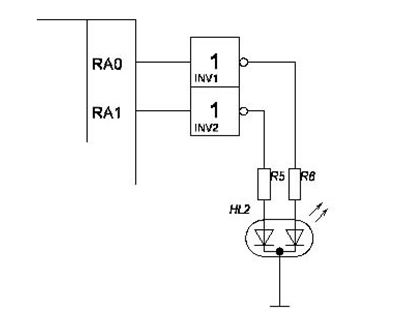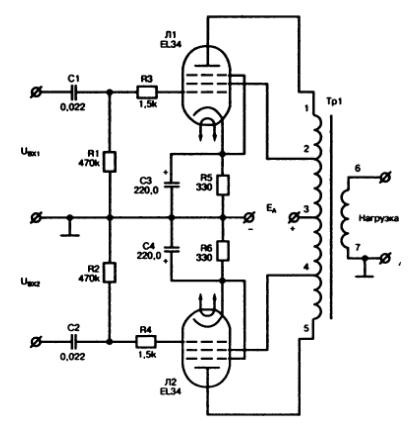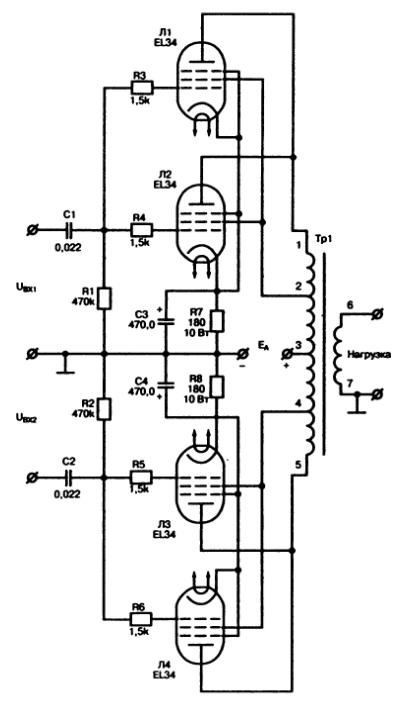Let's do one more experiment. Take several identical lamps and turn them on one after the other (Fig. 1.9). This connection is called serial. It should be distinguished from the previously discussed parallel connection.
Rice. 1.9. The generator powers two lamps connected in series. The diagram shows an ammeter and three voltmeters: one measures the total voltage, the other two measure the voltage across each of the lamps.
When several sections of the circuit (say, several lamps) are connected in series, the current in each of them is the same.
So, take two 100-watt lamps, the same as those considered in the previous experiment, and connect them in series to a generator with a voltage of 100 V.
The lamps will barely glow, their glow will be incomplete. Why? Because the source voltage (100 V) is divided equally between both lamps in series. Each of the lamps will now have a voltage not 100, but only 50 V.
The voltage across the lamps is the same because we took two identical lamps.
If the lamps were not the same, the total voltage of 100 V would be divided between them, but not evenly: for example, one lamp might have 70 V, and the other 30 V.
As we will see later, more powerful lamp receives less stress. But the current in two series-connected even different lamps remains the same. If one of the lamps burns out (a hair breaks), both lamps will go out.
In fig. 1.9 shows how you need to turn on the voltmeters in order to measure the voltage on each of the lamps separately.
Experience shows that the total voltage in successive sections of the circuit is always equal to the sum of the voltages in individual sections.
The lamps burned normally when the current was 1 A, but for this it was necessary to apply a voltage of 100 V to each of them. Now the voltage on each of the lamps is less than 100 V, and the current will be less than 1 A. It will not be enough to incandesce the lamp filament ...
We will now regulate the operation of the generator: we will increase its voltage. What happens then? Along with the increase in voltage, the current will increase.
The lamps will start to glow brighter. When, finally, we raise the voltage of the generator to 200 V, a voltage of 100 V (half of the total voltage) will be established on each of the lamps and the current of the lamps will increase to 1 A. And this is the condition for their normal operation. Both lamps will burn at full incandescence and consume their normal power - 100 watts. The total power delivered by the generator will be equal to 200 W (two lamps of 100 W each).
It would be possible to turn on not two lamps in series, but ten or five. In the latter case, experience would show us that the lamps will burn normally when the total voltage is increased to 500 V. In this case, the voltage at the terminals of each lamp (we assume all lamps are the same) will be 100 V. The current in the lamps will be and is now equal to 1 A ...
So we have five lamps in series; all lamps are on normally, each of them consumes 100 W of power, which means that general power will be equal to 500 watts.
In this case, the current on each of them will be the same, which simplifies control over it. But there are times when you can't do without a parallel connection.
For example, if there is a power source, and several LED bulbs must be connected to it, the total voltage drop on which exceeds the source voltage. In other words, the power supply from the source is not sufficient for the series-connected bulbs, and they do not light up.
Then the bulbs are included in the circuit in parallel and put their own resistor on each branch.
According to the laws of parallel connection, the voltage drop on each branch will be the same and equal to the source voltage, and the current may differ. In this regard, calculations to determine the characteristics of resistors will be carried out separately for each branch.
Why can't you connect all LED bulbs to one resistor? Because the production technology does not allow LEDs with perfectly equal characteristics to be made. LEDs have different internal resistance, and sometimes the differences in it are very strong even for the same models taken from the same batch.
A large spread in resistance leads to a spread in the value of the current, and this, in turn, leads to overheating and burnout. This means that it is necessary to control the current on each LED or on each branch with a serial connection. Indeed, with a serial connection, the current is the same. For this, separate resistors are used. With their help, the current is stabilized.
Main characteristics of circuit elements
With a little thought, it becomes clear that one branch can contain maximum amount LEDs is the same as when connected in series and powered from the same source.
For example, we have a 12 volt source. It can be connected in series with 5 LEDs of 2 volts. (12 volts: 2 volts: 1.15≈5). 1.15 is a safety factor, since it is necessary to calculate that a resistor will also be included in the circuit.
: I = U / R, where I will be the allowable current taken from the table of characteristics of the device. The voltage U will be obtained by subtracting the voltage drops across each LED in the serial string from the maximum voltage of the power source (also taken from the table of characteristics).
The power of the resistor is found from the formula:
In this case, all values are recorded in the C system. Recall that 1 A = 1000 mA, 1 mA = 0.001 A, 1 ohm = 0.001 kΩ, 1 W = 1000 mW.
There are many online calculators, which offer to perform this operation automatically, simply by substituting known characteristics v empty cells... But it's still useful to know the basic concepts.
The advantage of parallel connection of diodes
Parallel connection allows 2 or 5 or 10 LEDs or more to be added. The limitation is the power supply capacity and the size of the device in which you want to use such a connection.
The bulbs for each parallel branch are taken strictly the same so that they have the most similar values of the permissible current, forward and reverse voltage.
The advantage of connecting the LEDs in parallel is that if one of them burns out, the entire circuit will continue to run. The bulbs will glow even if more of them burn out, the main thing is that at least one branch remains intact.
As you can see, parallel connection is quite useful thing... You just need to be able to correctly assemble the circuit, not forgetting about all the properties of LEDs and the laws of physics.
In many circuits, parallel connection is combined with a serial connection, which makes it possible to create functional electrical devices.
Application of parallel connection of LEDs
Scheme parallel connection with two leads allows for the implementation of two-color glow of bulbs, if two crystals are used different color. The color changes when the poles of the source are changed (changing the direction of the current). Wide application such a pattern is found in two-color indicators.
If two crystals of different colors are connected in parallel in the same case and a pulse modulator is connected to them, then the color can be changed in wide range... Especially a lot of tones are generated when green and red LEDs are combined.

As you can see in the diagram, a resistor is connected to each crystal. The cathode in such a connection is common, and the entire system is connected to a control device - a microcontroller.
In modern holiday garlands, it is sometimes used mixed type a connection in which several consecutive rows are connected in parallel. This allows the garland to glow, even if several LED sources fail.
When creating a backlight in a room, they can also use a parallel connection. Mixed schemes are used in the design of many electrical indicator devices and for illuminating devices.
Several nuances of installation
Separately, we can say about how the LEDs are connected to each other. Each crystal is enclosed in a case from which leads are drawn. The terminals are often marked "-" or "+", which means, respectively, connection to the cathode and to the anode of the device.
Experienced radio amateurs can even determine the polarity by eye, since the cathode lead is slightly longer and protrudes slightly more from the case. The connection of the LEDs must be carried out strictly observing the polarity.
If it comes oh, then during the installation process, soldering is often used. To do this, use a low-power soldering iron, so as not to overheat the crystal. Soldering time should not exceed 4-5 seconds. Better if it is 1-2 seconds. For this, the soldering iron is preheated. The conclusions do not bend much. The circuit is assembled on the site from a material that removes heat well.
The output power of a single-ended ULF can be increased by connecting one or more lamps in parallel to the lamp of the output stage. Thus, at the same supply and anode voltage, the anode current and, accordingly, the output power of the stage increase by a factor of two or more. An example of parallel connection of an additional lamp in the final stage of a single-ended ULF is shown on rice. 1.
Fig. 1. Schematic diagram single-ended ULF on one (a) and two (b) pentodes
In the considered scheme ( rice. 1, a), the so-called ultralinear inclusion of the pentode is used, a characteristic feature of which is the connection of the cathode with a protective grid. The shielding grid of the pentode is connected to pin 2 of the output transformer Tpl, with the number of turns between pins 2 and 3 being approximately 43% of the number of turns between pins 1 and 3. The transformer Tpl is designed so that the primary impedance (pins 1-3) is equal to the value of the load resistance determined for each lamp according to the catalog specification. So, for example, for a lamp of the EL34 type, this resistance is approximately 3 kOhm. The auto-bias voltage is generated across resistor R3, which is shunted by electrolytic capacitor C2.
When an additional lamp (or lamps) is connected in parallel to the lamp of the output stage of the ULF, it will be necessary to correct the values of some elements. So, for example, when connecting one additional lamp ( rice. 1, b) the value of the resistance of the resistor R3 in the automatic bias circuit should be approximately halved in comparison with the previously considered circuit ( rice. 1, a), and the value of the capacity of the shunt capacitor C2 is doubled. This is due to the fact that when two lamps are connected in parallel, the cathode current doubles. It should be noted that the power of the resistor R3 must also be doubled, that is, from 5 to 10 W. To achieve a twofold increase in output power, it will also be necessary to reduce the primary impedance of the transformer Tpl by half.
Theoretically, in a similar way, a larger number of similar lamps with almost identical parameters can be connected in parallel to the output stage lamp. Therefore, on sale you can find already matched pairs and even four lamps for use in parallel connection of the ULF output stage.
As in a single-ended tube ULF, you can increase the output power of a push-pull amplifier by connecting one or more tubes in parallel to the lamps of the output stage. With the same supply and anode voltage, the anode current and, accordingly, the output power of the stage increase by a factor of two or more. We will explain the features of such a connection using the example of a simple push-pull power amplifier, a schematic diagram of which is shown in rice. 2.

Fig. 2. Schematic diagram of a simple push-pull power amplifier
This amplifier consists of two identical channels, each of which is based on the single-ended amplifier discussed earlier. An example of parallel connection of additional lamps in the final stage of such a push-pull ULF is shown on rice. 3.

Fig. 3. Schematic diagram of a simple push-pull power amplifier with parallel switching of lamps
When choosing the parameters of the elements for a push-pull lamp ULF with parallel connection of lamps, all the comments and recommendations mentioned earlier for a single-ended circuit are valid.




